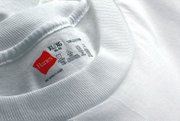Garment Makers Adopt Tagless Technology
The days of the T-shirt tag could be numbered. Tshirt, innerwear and sportswear makers are gradually adopting new technology that applies tagless labels using a heat-transfer process. Companies say the tagless technology produces products that are durable and more comfortable than those bearing woven labels.
Sportswear marketers, including Russell Athletic, have been experimenting with the process for several years, but the concept gained more ground this year after leading T-shirt and innerwear producer Hanes announced it was doing away with woven labels for all of its T-shirt products.
With its Super Bowl “Go Tagless” television advertisement, featuring NBA legend Michael Jordan, Hanes sent a message to the industry that tagless technology is the future.
For Hanes, comfort is the main objective. Hanes’ research showed traditional woven tags bother two-thirds of consumers. Additionally, half of those consumers cut tags out after buying products, said Hanes spokesperson Laura Burrows.
A number of technology providers, looking to cash in on the trend, are responding to Hanes’ move by creating new tagless systems.
This week, Woodland Hills, Calif.-based Tag-It Pacific Inc. released Slik-Label, a heat-transfer label system that works similarly to Hanes’ technology.
Another leading labels producer, Paxar Corp., will bring a comparable technology to the market in a few months, said Paxar’s Bob Powers. The White Plains, N.Y., company acquired Norwegian firm NTP Gandrudbakken AS last summer and will invest about $1 million to get its heat-transfer product online this year, according to Powers.
Tagless machines incorporate printing technology similar to that used in the silkscreen and embroidery businesses. Users can composite computer images onto fabrics to form labels, said Tag-It vice president of product development and sourcing Larry Dyne.
Dyne said the technology that Tag-It uses falls somewhere between that of silk-screen and offset presses. Tag-It machines generally cost between $800 and $1,500. However, for expansive operations, the process can be more complex and expensive than the creation of traditional woven labels.
“If you’re using just a plain black-andwhite label, the price is pretty comparable to a woven label, which costs about 4 or 5 cents a piece,” said Dyne. “But for 6 to 8 cents a piece, you can use color and even get into four-color-process images.”
While cotton T-shirts and underwear have been the primary targets for heat-transfer labels, the technology has also tested strongly with microfibers and stretch fabrics. These preliminary tests open the possibility of applying heat-transfer tags to more garment categories, said Dyne.
“It’s a versatile label because it has the capacity to stretch with the fabric it is applied onto,” said Tag-It chief executive officer Colin Dyne. “If the garment is being worn and stretched, the label will move easily with the fabric with no distortion of the fabric, which is ideal for innerwear, as well as T-shirts and other apparel types.”
Wholesalers have found the absence of tags to be a good selling point.
“It has a cleaner look,” said Ronda Walker, owner of Republica, a Los Angeles-based apparel showroom. Walker also produces the semiannual POOL trade show, which is dominated by T-shirt vendors. Walker said many of those vendors have been shifting to tagless products.
“I think it’s here to stay,” she added.
Others aren’t quite so sure. “It’s probably going to take some time to get off the ground,” said David Lawrence of Bell, Calif.- based Progressive Label Inc. “We haven’t dabbled in it yet, and being a label producer, I hope it doesn’t take off.”
Maryann Alpert of New York-based Alkahn Label thinks most garment makers will stick with traditional woven labels.
“It’s a gimmick,” she said.






















